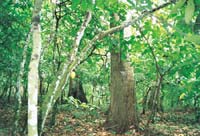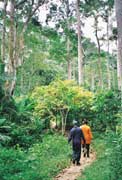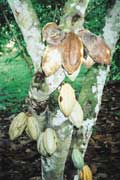
Case study: Sustainable cocoa production in Cameroon

Cocoa growing under the forest canopy (agroforestry)
(Click for a larger image) |
Cameroon produced 105,000 tonnes (3.8% of the world total) of cocoa beans in 1998. The varieties grown here produce a reddish coloured cocoa powder used in the baking, biscuit and ice cream industries. Usually only the relatively flavourless cocoa butter from Cameroon is used in the chocolate industry. Cocoa production is virtually all on small farms. Yields are poor and heavy year-round rainfall in some areas makes the cocoa susceptible to diseases and hard to dry in the sun.
Cocoa farms in some regions of Cameroon are found on selectively cleared forest land. When land is cleared, indigenous fruit, medicinal and timber tree species are left standing, for their economic value and to provide shade for cocoa trees. As a result cocoa is grown in a multi-product, multi-strata agroforest. Food crops such as maize and melons are planted with the cocoa, then more maize, cassava and plantain while the cocoa trees develop. The system can be enriched by planting additional tree crops like mango, African plum, avocado, cola, orange, oil palm, coconut and rubber. This gradually develops into a closed canopy, multi-strata system similar to a natural forest.

Cocoa agroforestry, Cameroon, showing tree layers
(Click for a larger image)
|
These cocoa agroforests have the following advantages:
- they come close to the nutrient recycling system of a natural forest
- they have nearly two thirds of the carbon stock of a natural forest - better than fallow land or food crop fields
- they have greater plant biodiversity and micro-fauna than crop fields
- they are economically more attractive (especially cocoa plus fruit trees) than other systems
Work is underway to domesticate some of the indigenous trees traditionally grown with cocoa to provide better timber and non-timber forest products (NTFPs) and enhance rural livelihoods. Little or no formal research has yet been done on these wild species and work is needed to find ways of propagating the best varieties of these "companion" trees.

Diseased cocoa pods
(Click for a larger image)
|
The biggest problem facing cocoa farmers in Cameroon is the fungal disease Black Pod. The chocolate industry is supporting research to help develop varieties of cocoa tree more resistant to the disease, enabling farmers to get better yields. Work is also beginning on using biological control systems to combat the disease. Fungi antagonistic to the Black Pod fungus are isolated from the soil, grown up in culture and then sprayed on infected trees. The antagonistic fungus then inhibits the growth of Black Pod fungus. This method avoids the use of expensive, inefficient and potentially environmentally damaging chemicals.
